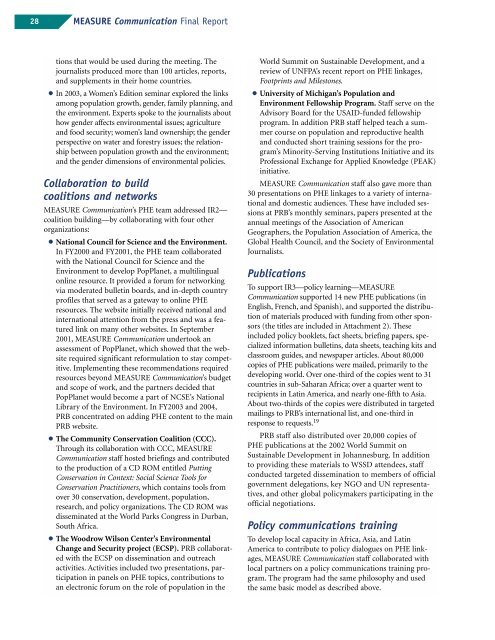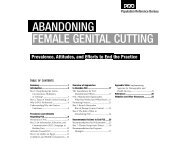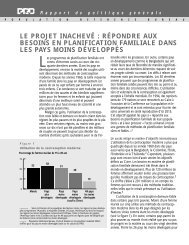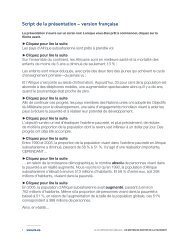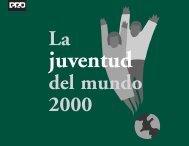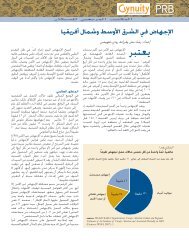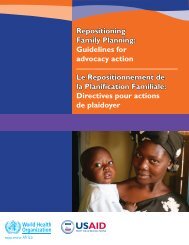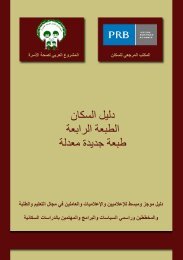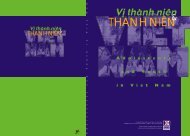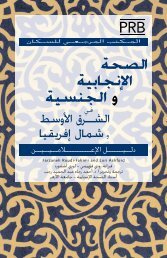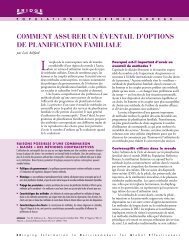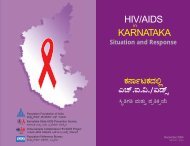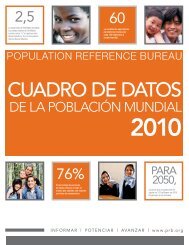MEASURE Communication Final Report - Population Reference ...
MEASURE Communication Final Report - Population Reference ...
MEASURE Communication Final Report - Population Reference ...
Create successful ePaper yourself
Turn your PDF publications into a flip-book with our unique Google optimized e-Paper software.
28 <strong>MEASURE</strong> <strong>Communication</strong> <strong>Final</strong> <strong>Report</strong><br />
tions that would be used during the meeting. The<br />
journalists produced more than 100 articles, reports,<br />
and supplements in their home countries.<br />
● In 2003, a Women’s Edition seminar explored the links<br />
among population growth, gender, family planning, and<br />
the environment. Experts spoke to the journalists about<br />
how gender affects environmental issues; agriculture<br />
and food security; women’s land ownership; the gender<br />
perspective on water and forestry issues; the relationship<br />
between population growth and the environment;<br />
and the gender dimensions of environmental policies.<br />
Collaboration to build<br />
coalitions and networks<br />
<strong>MEASURE</strong> <strong>Communication</strong>’s PHE team addressed IR2—<br />
coalition building—by collaborating with four other<br />
organizations:<br />
● National Council for Science and the Environment.<br />
In FY2000 and FY2001, the PHE team collaborated<br />
with the National Council for Science and the<br />
Environment to develop PopPlanet, a multilingual<br />
online resource. It provided a forum for networking<br />
via moderated bulletin boards, and in-depth country<br />
profiles that served as a gateway to online PHE<br />
resources. The website initially received national and<br />
international attention from the press and was a featured<br />
link on many other websites. In September<br />
2001, <strong>MEASURE</strong> <strong>Communication</strong> undertook an<br />
assessment of PopPlanet, which showed that the website<br />
required significant reformulation to stay competitive.<br />
Implementing these recommendations required<br />
resources beyond <strong>MEASURE</strong> <strong>Communication</strong>’s budget<br />
and scope of work, and the partners decided that<br />
PopPlanet would become a part of NCSE’s National<br />
Library of the Environment. In FY2003 and 2004,<br />
PRB concentrated on adding PHE content to the main<br />
PRB website.<br />
● The Community Conservation Coalition (CCC).<br />
Through its collaboration with CCC, <strong>MEASURE</strong><br />
<strong>Communication</strong> staff hosted briefings and contributed<br />
to the production of a CD ROM entitled Putting<br />
Conservation in Context: Social Science Tools for<br />
Conservation Practitioners, which contains tools from<br />
over 30 conservation, development, population,<br />
research, and policy organizations. The CD ROM was<br />
disseminated at the World Parks Congress in Durban,<br />
South Africa.<br />
● The Woodrow Wilson Center’s Environmental<br />
Change and Security project (ECSP). PRB collaborated<br />
with the ECSP on dissemination and outreach<br />
activities. Activities included two presentations, participation<br />
in panels on PHE topics, contributions to<br />
an electronic forum on the role of population in the<br />
World Summit on Sustainable Development, and a<br />
review of UNFPA’s recent report on PHE linkages,<br />
Footprints and Milestones.<br />
● University of Michigan’s <strong>Population</strong> and<br />
Environment Fellowship Program. Staff serve on the<br />
Advisory Board for the USAID-funded fellowship<br />
program. In addition PRB staff helped teach a summer<br />
course on population and reproductive health<br />
and conducted short training sessions for the program’s<br />
Minority-Serving Institutions Initiative and its<br />
Professional Exchange for Applied Knowledge (PEAK)<br />
initiative.<br />
<strong>MEASURE</strong> <strong>Communication</strong> staff also gave more than<br />
30 presentations on PHE linkages to a variety of international<br />
and domestic audiences. These have included sessions<br />
at PRB’s monthly seminars, papers presented at the<br />
annual meetings of the Association of American<br />
Geographers, the <strong>Population</strong> Association of America, the<br />
Global Health Council, and the Society of Environmental<br />
Journalists.<br />
Publications<br />
To support IR3—policy learning—<strong>MEASURE</strong><br />
<strong>Communication</strong> supported 14 new PHE publications (in<br />
English, French, and Spanish), and supported the distribution<br />
of materials produced with funding from other sponsors<br />
(the titles are included in Attachment 2). These<br />
included policy booklets, fact sheets, briefing papers, specialized<br />
information bulletins, data sheets, teaching kits and<br />
classroom guides, and newspaper articles. About 80,000<br />
copies of PHE publications were mailed, primarily to the<br />
developing world. Over one-third of the copies went to 31<br />
countries in sub-Saharan Africa; over a quarter went to<br />
recipients in Latin America, and nearly one-fifth to Asia.<br />
About two-thirds of the copies were distributed in targeted<br />
mailings to PRB’s international list, and one-third in<br />
response to requests. 19<br />
PRB staff also distributed over 20,000 copies of<br />
PHE publications at the 2002 World Summit on<br />
Sustainable Development in Johannesburg. In addition<br />
to providing these materials to WSSD attendees, staff<br />
conducted targeted dissemination to members of official<br />
government delegations, key NGO and UN representatives,<br />
and other global policymakers participating in the<br />
official negotiations.<br />
Policy communications training<br />
To develop local capacity in Africa, Asia, and Latin<br />
America to contribute to policy dialogues on PHE linkages,<br />
<strong>MEASURE</strong> <strong>Communication</strong> staff collaborated with<br />
local partners on a policy communications training program.<br />
The program had the same philosophy and used<br />
the same basic model as described above.


